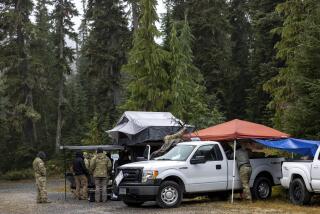Filming of Flight Caused Deaths of 2
- Share via
WASHINGTON — A Navy pilot and his adopted brother died in a plane crash last summer at least in part because the pilot was trying to videotape his flight maneuvers with a camera at the same time he was flying the plane, the Navy has concluded.
Lt. Anthony G. Gragg, 28, of San Leandro, Calif., and his adopted brother, William F. Cornwell, 39, died last July 26 when the T-34B Mentor trainer Gragg was flying failed to recover from a looping maneuver near Empire, Nev., 80 miles northeast of Reno.
The Navy’s formal accident investigation report has not been released publicly, although the Navy said Friday it had been completed. But a summary of the findings were disclosed in an official periodical, Naval Aviation News, which is distributed bimonthly to Navy fliers.
Reviews Accidents
The publication includes a special section entitled “Grampaw Pettibone Says” that omits names but reviews recent accident reports and then offers the wisdom of “Grampaw” to explain in folksy style what went wrong.
A Navy official who asked not to be identified said the service was not prepared to discuss the results of the investigation, but that Naval Aviation News had, in fact, been recounting details of the Nevada accident.
According to the summary, “A naval aviator, against all regulations and without permission, transported a male civilian to whom he was related on two flights.”
Video Camera
“A video camera was carried on these trips to film activities during the sorties. On the day of the third flight . . . the passenger filmed the majority of the flight sequences en route to a destination where the two had lunch with a relative and friend.”
After another hop to visit relatives, the two men took off from Empire to return to the plane’s base outside San Francisco, “proceeded north, then turned west, climbing to 1,500 feet,” the summary continued.
“In the climb, the pilot asked for the camera and turned back toward the departure point (the airport). Completing the turn, the pilot began a shallow dive, gathering speed to perform a loop, which he initiated at 150 knots.
“The loop was not completed. Instead the pilot executed an immelman, topping out at 1,200 feet above ground in a nose high attitude with 65 knots air speed and 23 inches of manifold pressure. The pilot was apparently recording the maneuver with the camera which, at this point, fell to the cockpit floor.”
An immelman is a maneuver in which a pilot stops his loop at the very top and returns to level flight.
Violent Spin
“The aircraft flew straight and level for two or so seconds, dropped off on the right wing, then entered a violent right-hand spin,” the account added. “After one revolution, the spin decreased into a right-hand spiral and the aircraft plummeted steeply toward the ground. The tape was recovered and used in the subsequent mishap investigation.”
More to Read
Sign up for Essential California
The most important California stories and recommendations in your inbox every morning.
You may occasionally receive promotional content from the Los Angeles Times.










